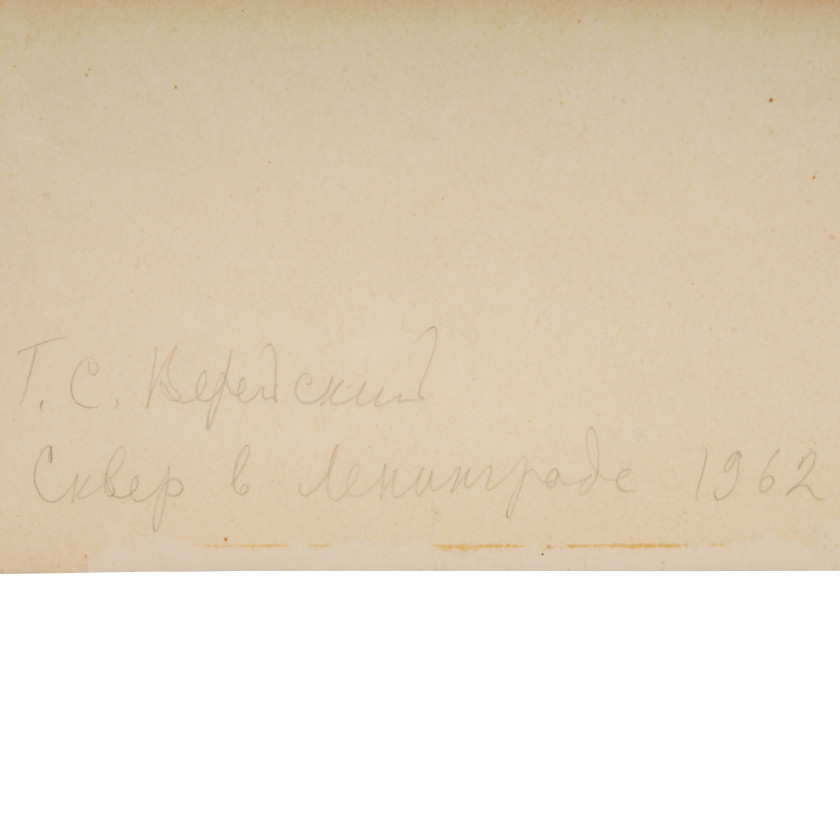Autolithography "Square in Leningrad"
-
140.00 EUR
Artist/Maker: Vereysky Georgy
Artist/Maker Dates: 1886 - 1962
Place of Production: Russia (USSR), Saint Petersburg (Leningrad)
Date of Production: 1962
Materials: lithography, paper
Width: 36.0 cm.
Height: 50.0 cm.
Condition:
Condition notes: Wear consistent with age and use
Description
Vereisky studied under E. E. Schroeder at the private studio in Kharkov (1896, 1900–1904). It was his first art education. In 1904–1912 he studied law in Kharkov, and then at St. Petersburg University.
In 1904 he started to exhibit his works. In 1905 Vereisky was arrested for participation in the revolutionary movement. In 1905–1907 he lived abroad — in Munich, Vienna, Italy. During 1913–1916 he studied at the New Art workshop under M. V. Dobuzhinskiy, B. M. Kustodiev, A. P. Ostroumova-Lebedeva, and E. E. Lanceray. Vereisky participated in the exhibitions of the group Mir Iskusstva (“World of Art”).
Since 1912 he collaborated with the magazines Teatr i iskusstvo (“Theatre and Art”), Golos zhizni (“Voice of Life”), where he published his portraits, caricatures and theatre sketches. Since that time Vereisky started to gain popularity as a portraitist.
In 1916 Vereisky was inducted into the armed forces; in 1918 he was demobilized. During this period, Vereisky created a number of front-line sketches. In 1918 he taught at the A. L. Stieglitz Higher Courses of Arts (formerly the Central School of Technical Drawing under Baron A. Stieglitz) and the Higher Institute of Photography and Phototechnique, in 1921–1924 — at the Higher State Artistic and Technical Workshops (VKhUTEMAS) and at the Higher Art Technical Institute (VKhUTEIN) in Petrograd. In 1918 he became a curator, and then a head of Engraving Department of the State Hermitage Museum; he worked there till 1930.
In 1920 Vereisky created a series of portrait drawings of V. I. Lenin at the 3rd Congress of the Communist International. In 1924 the first personal exhibition of the artist was held in Kazan. Vereisky was engaged in etching. In 1920s he started to work in the field of lithography. He created albums of lithographs Portraits of Russian Artists (1922, 1926), Village (1924), Russian Writers (1927, 1929), Fourteen portraits (1928), and Military Air Fleet of the USSR (1934). Since 1933 he worked in experimental lithographic workshop at Leningrad department of the Union of Soviet Artists (LOSSKh).
In 1942–1945 Vereisky lived in Moscow, created anti-fascist posters. In 1946 he was awarded the Stalin Prize for the album Portraits of leaders of the Soviet state, pilots and workers of the Soviet culture. In the same year he was conferred the title of Honored Art Worker of the RSFSR (Russian Soviet Federative Socialist Republic). In 1949 he became a member of the USSR Academy of Arts. In 1962 Vereisky was conferred the title of People's Artist of the RSFSR.
Vereisky was father of the artist Orest Georgievich Vereisky (1915–1993).
Georgy Vereisky was one of the most significant representatives of the Soviet graphic art, who continued classical traditions of painting and engraving. He painted almost merely from nature. Vereisky was best known for this portrait works. His works were distinguished by precision of the plastic and psychological characteristic of the models. He created a series of landscapes, still lifes and genre compositions. Vereisky preferred monotonous black and white graphics, and he most commonly used ink, black watercolor and graphite pencil in drawings.
Works by Georgy Vereisky are in many museum and private collections, including the State Tretyakov Gallery, the State Russian Museum, the Pushkin State Museum of Fine Arts and others.
Shipping details
- Log in to see the cost for shipping this lot to your address.
Shipping methods are determined by item size, type, fragility and specific characteristics.
Shipping costs are calculated based on carrier rates, delivery distance and packing complexity.
Payment details
Doma Antikvariāts accepts the following payment methods:








